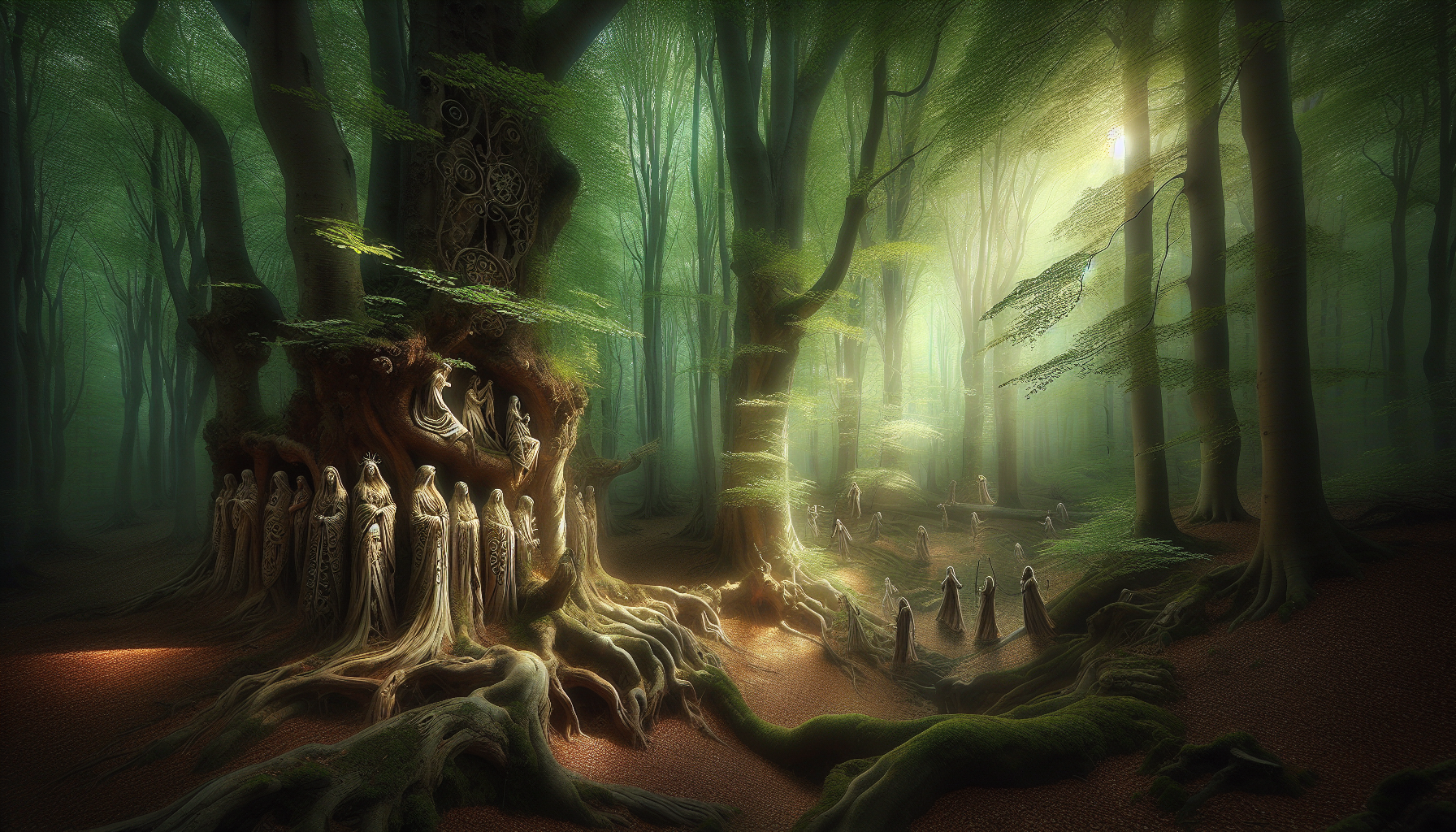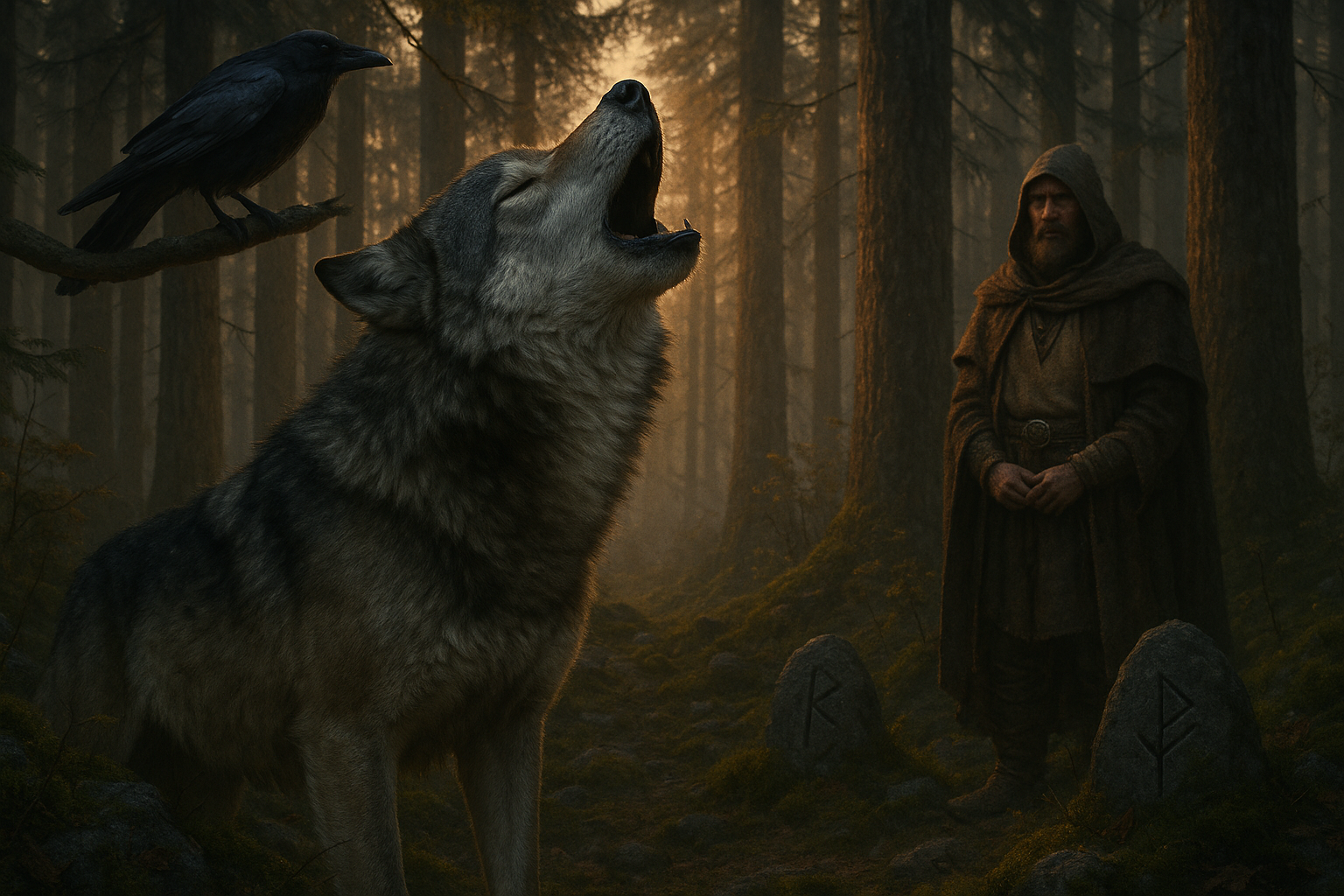In the heart of Eastern Europe, where dense forests weave through the landscape like nature’s own intricate tapestry, ancient trees stand as silent sentinels to a world brimming with magic and mystery. These trees, some towering with age and others whispering with the winds, are not mere components of the scenery. They are storied beings, deeply enshrined in the vibrant and colorful tapestry of Slavic folklore. To the Slavs, trees were more than just part of the natural environment—they were sacred entities, keepers of ancestral wisdom, and bridges to the divine. 🌳
As we embark on this journey through the enchanting world of Slavic folklore, we will unveil the mystical whispers of these majestic trees, exploring the legends and spiritual significance that have been passed down through generations. From the revered oak, believed to be the abode of the mighty god Perun, to the mysterious birch, a symbol of protection and new beginnings, each tree holds its own unique place within the pantheon of nature. These stories and beliefs are not just relics of the past; they continue to shape cultural identities, influence traditions, and inspire a deep reverence for nature in the modern world.
Our exploration begins with an understanding of the spiritual symbolism and roles that trees play in Slavic mythology. We will delve into the tales of sacred groves, where rituals were performed and offerings made to appease the spirits residing within the branches and roots. These groves were believed to be powerful places where the earthly and the ethereal converged, allowing for communion with the divine. We’ll also examine how these beliefs influenced the daily lives of the Slavic people, from their agricultural practices to their festive celebrations, reflecting a harmonious relationship with the natural world that modern society often yearns to rediscover.
Furthermore, we’ll uncover the intriguing characters and narratives that populate Slavic tree folklore. Discover the tale of the Leshy, the forest guardian spirit known for leading wanderers astray, and the mythical Rusalka, the enigmatic water nymphs said to dwell among the trees and streams. These stories not only entertain but also offer profound insights into the values, fears, and aspirations of the people who told them. By understanding these narratives, we gain a deeper appreciation for the interconnectedness of human existence with nature and the spiritual world.
Finally, we’ll consider the enduring legacy of these arboreal legends in contemporary culture. From literature and art to environmental movements, the influence of these ancient beliefs can be seen in various facets of modern life. As we reflect on the spiritual significance of trees in Slavic folklore, we are reminded of the timeless wisdom they offer and the lessons we can learn from them in our quest for a more balanced and harmonious existence with nature. Through this journey, we invite you to listen to the whispers of the trees and discover the enchanting world of Slavic folklore, where every rustle of leaves and creak of branches tells a story waiting to be heard. 🌲
The Enchantment of Trees in Slavic Folklore
Slavic folklore is a treasure trove of enchanting legends and mystical tales, where the natural world plays a crucial role in shaping the cultural and spiritual landscape. Among the myriad elements of nature that populate these stories, trees stand as profound symbols of life, growth, and spiritual connection. In Slavic culture, trees are not merely passive elements of the landscape; they are imbued with life and meaning, often acting as conduits between the physical and spiritual realms. This deep-seated reverence for trees can be seen across various Slavic myths and legends, where trees are depicted as guardians of wisdom, homes to spirits, and markers of sacred spaces.
Throughout Slavic folklore, different types of trees are associated with specific legends and spiritual significances. The oak, for instance, is often revered as the king of the forest, embodying strength, endurance, and protection. In many tales, the oak tree is a sacred dwelling for powerful deities and spirits. Meanwhile, the birch is celebrated for its purity and resilience, frequently linked to feminine energies and often featured in rites of passage and rituals of renewal. These associations are not arbitrary; they reflect a deep understanding of the natural environment and its cycles, as well as a profound appreciation for the interconnectedness of all living things.
One captivating aspect of Slavic tree lore is the belief in the “whispering trees,” where it is said that trees can communicate with those who listen carefully. This belief highlights the mystical qualities attributed to trees, suggesting that they hold ancient knowledge and secrets. This notion is beautifully illustrated in stories where humans seek guidance or wisdom by listening to the rustling leaves of ancient trees. Such stories emphasize the importance of attunement to nature and suggest a spiritual symbiosis between humans and the natural world. The whispering trees serve as reminders of the unseen forces that shape the universe and the potential for deeper understanding through harmonious coexistence with nature.
Symbolism and Spiritual Significance of Trees
Delving into the symbolism of trees in Slavic folklore, one finds a rich tapestry of meanings that reflect the cultural values and spiritual beliefs of the Slavic people. Each tree species carries unique attributes that have been passed down through generations, forming a symbolic language that speaks to the soul’s journey and the mysteries of life and death. The symbolism of trees in Slavic folklore often revolves around themes of fertility, protection, and transformation, with each tree acting as a metaphor for human experiences and spiritual growth.
Take, for example, the linden tree, which is deeply rooted in Slavic traditions as a symbol of love and marriage. The linden’s heart-shaped leaves and fragrant flowers make it a fitting emblem of romantic and familial bonds. In many Slavic cultures, it is customary for newlyweds to plant a linden tree as a representation of their union and the hope for a fruitful and enduring partnership. The linden’s role as a symbol of love extends beyond personal relationships, representing a broader sense of community and interconnectedness within the human family.
In contrast, the yew tree is often associated with death and rebirth, owing to its evergreen nature and ability to thrive in adverse conditions. The yew’s dark, dense foliage and slow growth evoke the mysteries of the afterlife and the cyclical nature of existence. In Slavic folklore, yew trees are frequently found in cemeteries, serving as sentinels that guard the souls of the departed and facilitate their journey to the other side. This association with the afterlife underscores the reverence for trees as symbols of continuity and the perpetual cycle of life, death, and renewal.
The Role of Trees in Slavic Rituals and Traditions
Trees play a vital role in various Slavic rituals and traditions, where they are revered as sacred objects and integral components of spiritual practices. From seasonal festivals to rites of passage, trees are central to many cultural celebrations and serve as focal points for communal gatherings. The rituals surrounding trees often involve offerings, prayers, and symbolic acts that honor the tree’s spirit and seek its blessing for prosperity, protection, and guidance.
One of the most well-known tree-related rituals in Slavic folklore is the “Midsummer Night” celebration, also known as “Kupala Night.” This festival marks the summer solstice and is celebrated with bonfires, dancing, and the weaving of flower crowns. Trees, particularly the birch, play a significant role in this celebration, symbolizing purification and renewal. Participants often jump over bonfires, believed to cleanse them of evil spirits, and engage in rituals to divine their future, often with the assistance of tree branches or wreaths.
The significance of trees in Slavic rituals extends to personal milestones, such as births and weddings. It is a common practice to plant a tree in honor of a newborn, symbolizing the child’s growth and the hope for a prosperous future. Similarly, trees are incorporated into wedding ceremonies, where couples may exchange vows beneath a tree or plant one together to signify the strength and endurance of their union. These traditions highlight the enduring connection between trees and the human life cycle, underscoring the belief that trees are living embodiments of spiritual and emotional bonds.
Comparative Table: Tree Symbolism in Slavic Folklore
| Tree | Symbolism | Associated Rituals |
|---|---|---|
| Oak | Strength, Protection | Offerings to deities, forest guardianship |
| Birch | Purity, Renewal | Midsummer Night, rites of passage |
| Linden | Love, Marriage | Wedding ceremonies, community bonding |
| Yew | Death, Rebirth | Cemetery guardianship, afterlife rituals |
Take a moment to explore the symbolism of these trees by watching the following video, which delves into the enchanting world of Slavic myths and their deep-rooted connections to nature. [Link to video: “The Enchanted Forest: Trees in Slavic Mythology” on the “Mythical Realms” channel]
Conclusion
The mystical whispers of trees in Slavic folklore reveal a profound appreciation for the natural world and its spiritual dimensions. Through their symbolism, trees offer insights into the mysteries of life and the human experience, serving as reminders of the interconnectedness of all things. By exploring the enchanting legends and spiritual significance of trees in Slavic culture, one gains a deeper understanding of the cultural heritage and spiritual values that continue to inspire and resonate across generations.

Conclusion
In conclusion, the exploration of the mystical whispers of trees in Slavic folklore unveils a rich tapestry of legends and spiritual significance that transcends mere storytelling. This journey into the enchanting world of Slavic beliefs has revealed how deeply intertwined humans and nature are, particularly in the Slavic cultural context. 🌿
Throughout this article, we have delved into the captivating stories that portray trees as sacred entities, guardians, and even as channels to the divine. From the revered oak, often seen as a symbol of strength and endurance, to the mystical birch, associated with renewal and protection, each tree in Slavic folklore carries its own unique symbolism and spiritual weight. These trees are not just part of the landscape; they are alive with stories, wisdom, and magic.
One of the key points discussed is the notion of trees as sacred beings and their roles in mediating between the earthly and the spiritual realms. This is evident in the legends that speak of trees housing the souls of ancestors or serving as conduits for communication with the divine. Such beliefs underscore a profound respect for nature and highlight the holistic view of the universe prevalent in Slavic cultures.
Moreover, we examined the spiritual practices and rituals that involve trees, such as the use of specific types of wood in ceremonies and the planting of trees as acts of worship or remembrance. These practices reflect an intrinsic belief in the interconnectedness of life and the cyclical nature of existence, which are central themes in Slavic spirituality.
The importance of preserving these legends cannot be overstated. They are not only a vital part of cultural heritage but also offer timeless lessons about living in harmony with nature. In an era where environmental concerns are at the forefront of global discourse, the wisdom embedded in these stories is more relevant than ever. They remind us of the need to respect and nurture our natural world, recognizing it as an integral part of our spiritual and physical well-being.
As you reflect on the enchanting legends and spiritual significance of trees in Slavic folklore, consider how these ancient beliefs resonate with contemporary values. The reverence for nature, the understanding of the symbiotic relationship between humans and the environment, and the celebration of life’s cycles are all lessons that remain pertinent today. 🌳
We encourage you to delve deeper into the mystical world of Slavic folklore and explore its relevance in modern times. Share these stories with others, spark discussions, and consider how these age-old beliefs can inspire a more harmonious relationship with the natural world. By doing so, you contribute to the preservation of these invaluable cultural treasures and promote a greater awareness of our place within the natural order.
Feel free to share your thoughts in the comments section below. We’d love to hear how these legends resonate with you or any personal experiences you may have had with nature that echo the themes discussed. If you found this exploration inspiring, don’t hesitate to share it with others who might also appreciate the mystical whispers of trees. 🌿✨
For further reading and to delve deeper into Slavic folklore, consider exploring reliable sources such as the or the University of Pittsburgh’s Library on Slavic Studies. These resources offer a wealth of information on the rich traditions and beliefs that have shaped Slavic cultures throughout history.
In closing, may the enchanting legends of trees in Slavic folklore inspire you to see the natural world with new eyes and kindle a deeper connection with the environment around you. Let these stories remind you of the beauty and magic that exist within the whispers of the trees. 🌲
Toni Santos is a sound storyteller and folklore researcher whose creative path bridges the mystical and the biological through the lens of bioacoustic folklore. With an ear attuned to the voices of nature, Toni explores how ancient cultures interpreted birdsong, forest echoes, and animal calls—not as noise, but as messages, omens, and myths encoded in sound.
Rooted in a passion for both natural science and ancestral lore, his work uncovers the forgotten connections between ecosystems and oral traditions. From the whispered warnings in owl cries to the songs of frogs heralding rain, Toni’s narratives evoke a time when humans listened to nature with reverence and meaning.
Drawing on a background in ecological arts and auditory storytelling, Toni merges field recordings with mythic imagery, turning natural sounds into cultural artifacts of wonder. His stories do more than entertain—they restore a way of hearing the world that blends intuition, memory, and deep listening.
As the creative force behind Vizovex, Toni offers sonic tales, symbolic soundscapes, and research-based reflections that help others rediscover the sacred language of the wild.
His work is a tribute to:
The mythological significance of animal and elemental sounds
Ancient practices of listening for meaning in nature
The spiritual dialogue between humans and soundscapes
Whether you’re a folklorist, an acoustic ecologist, or a curious listener, Toni invites you into a world where the forest speaks, and every chirp, croak, and howl carries a story—one echo, one legend, one call at a time.



